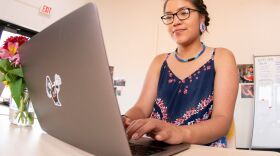A new website tells stories from five Native leaders about their cultural and spiritual ties to the Grand Canyon. The images, videos, and audio clips gathered on the site are part of a larger effort to improve education about the Grand Canyon’s indigenous history. KNAU’s Melissa Sevigny spoke about the project with Sarana Riggs, program manager at the nonprofit Grand Canyon Trust.
Melissa Sevigny: How did the idea for this project come about?
Sarana Riggs: The idea for this project stemmed from the Intertribal Centennial Conversation group. The group consists of community members from the 11 tribes surrounding the Grand Canyon on the Colorado Plateau…. It’s put together for not just the individuals out in Grand Canyon, tourists… but it’s more for our own tribal communities, our youth, our own people who are interested in who we are, and what to learn a little bit more, and seek that knowledge.
Melissa Sevigny: For a lot of nonindigenous people, visiting the Grand Canyon is a bucket list item, something you check it off your list. But this website tells stories about the Grand Canyon that are very different from that.
Sarana Riggs: Yes. What I hear when I talk to people is that it brings a little sense of peace, and you’re in awe of this beauty that was carved out by water, wind, the elements. It took time… Even at night it’s hauntingly beautiful because it’s dark and mysterious out there. What you feel and how you interact with the canyon is what we have known for a long time.
Melissa Sevigny: Let’s listen to a piece from Nikki Cooley; she’s talking about what it was like being a river guide down Grand Canyon and talking to the tourists about things.
Nikki Cooley [recorded]: One of the questions I got, too, was “I just really love your tan, how did you get that?” She was very serious abut that question. She was tanning the whole time. You get ridiculous questions like that. But also, you can’t shut them down because they also need to learn.
Melissa Sevigny: Do you think that kind of experience is common at the Grand Canyon for indigenous people?
Sarana Riggs: Yes. I think so. It’s not just Grand Canyon, it’s prevalent everywhere. My mom sells jewelry… I know that I’ve been asked a series of questions, being there by my mom’s side: do you guys still live in tipis? My response is, no, we don’t live in tipis. In Navajo that’s not our home, our homes are Hogans… And then you get somebody who says: do you still hunt buffalo? No, we go to McDonalds and buy food from the grocery store.
Melissa Sevigny: How do you help this website is going to start changing some of those misperceptions?
Sarana Riggs: I don’t think it’s going to change anybody’s mind right at this second and at this point. But I think it’s an acknowledgement that, “oh, I didn’t know there was another side of the story.”…All that romanticized notion of what you see on movies and TV, that’s not who we are, that doesn’t depict who we are. If you want to understand who we are, I think it’s important that you go into our communities, not just Grand Canyon National Park, and really understand and learn and listen, because there’s people who are willing to teach.
Melissa Sevigny: There’s a note at the end of this website asking people to share their own stories about Grand Canyon. I’m wondering how you hope this project is going to grow over time?
Sarana Riggs: We really are trying to reach out to our indigenous communities and all the tribes associated with Grand Canyon. We want to hear that story… That’s the ultimate purpose of what this platform is… because if we don’t share this knowledge passed on to us, it’s going to disappear over time, and that’s not something we want.








